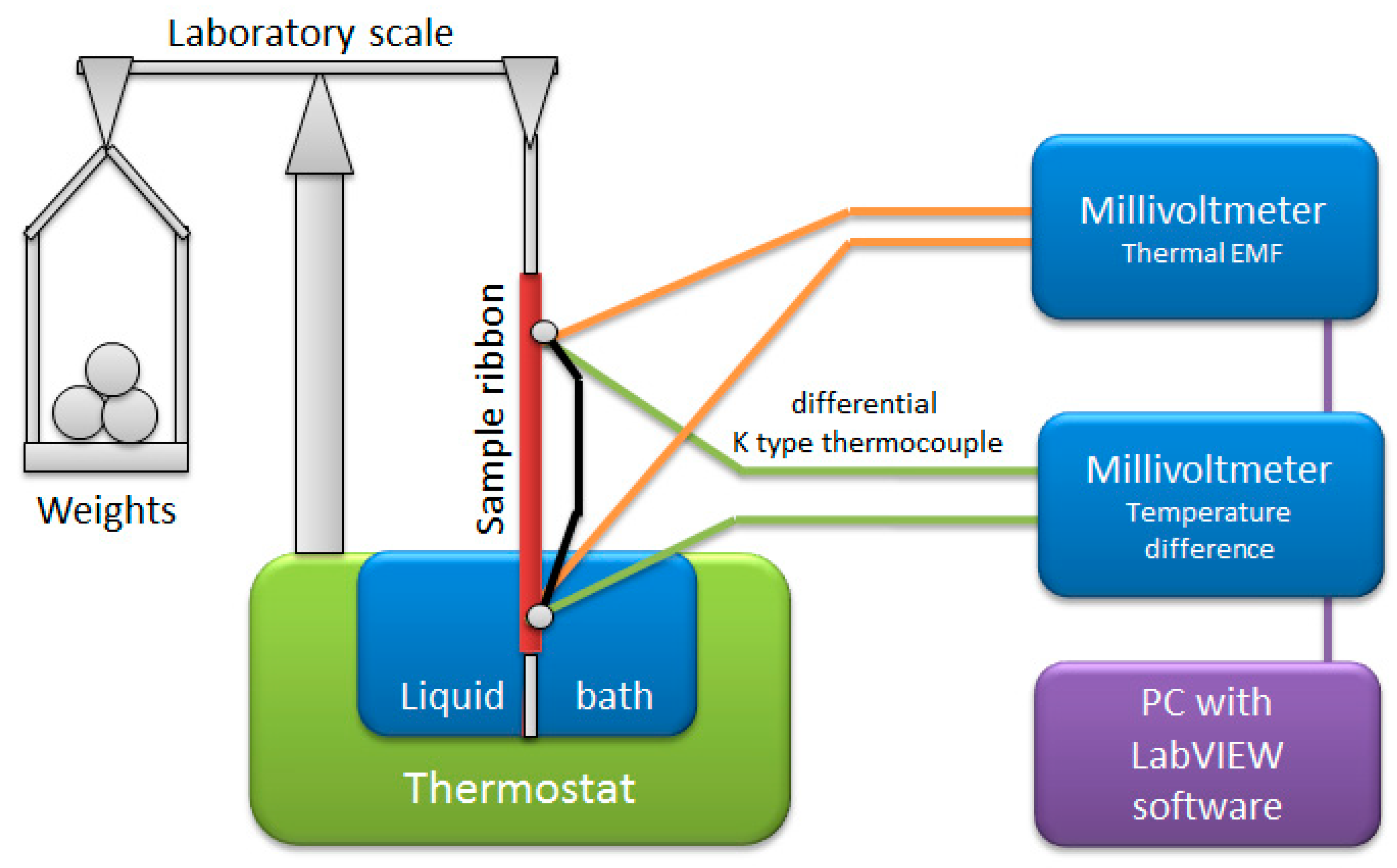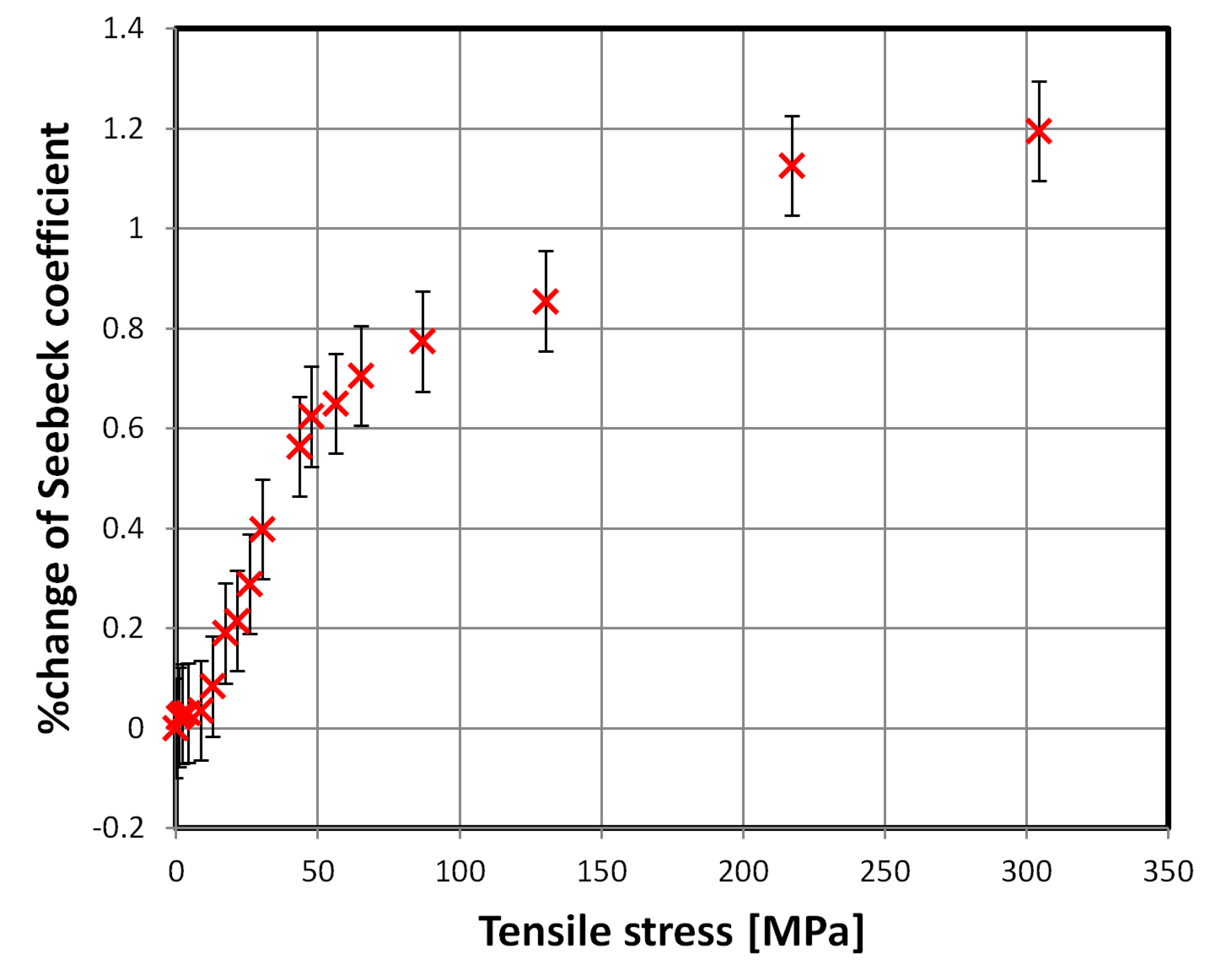Stress Dependence of Seebeck Coefficient in Iron-Based Amorphous Ribbons
Abstract
:1. Introduction
2. Materials and Methods
2.1. Utilized Samples
2.2. Measurement Method
3. Results and Discussion
4. Conclusions
Funding
Conflicts of Interest
References
- Egami, T. Magnetic amorphous alloys: Physics and technological applications. Rep. Prog. Phys. 1984, 47, 1601. [Google Scholar] [CrossRef]
- Schuh, C.A.; Hufnagel, T.C.; Ramamurty, U. Mechanical behavior of amorphous alloys. Acta Mater. 2007, 55, 4067–4109. [Google Scholar] [CrossRef]
- Nosenko, V.K.; Maslov, V.V.; Kirilchuk, V.V.; Kochkubey, A.P. Some industrial applications of amorphous and nanocrystalline alloys. J. Phys. Conf. Ser. 2008, 7, 1–6. [Google Scholar] [CrossRef]
- Egami, T.; Flanders, P.J.; Graham, C.D., Jr. Amorphous alloys as soft magnetic materials. AIP Conf. Proc. 1975, 24, 697–701. [Google Scholar]
- Hasegawa, R. Applications of amorphous magnetic alloys. Mater. Sci. Eng. A 2004, 375, 90–97. [Google Scholar] [CrossRef]
- Makhotkin, V.E.; Shurukhin, B.P.; Lopatin, V.A.; Marchukov, P.Y.; Levin, Y.K. Magnetic field sensors based on amorphous ribbons. Sensor. Actuat. A Phys. 1991, 27, 759–762. [Google Scholar] [CrossRef]
- Okazaki, Y.; Ueno, K. Magnetic shielding by soft magnetic materials in alternating magnetic field. J. Magn. Magn. Mater. 1992, 112, 192–194. [Google Scholar] [CrossRef]
- Callen, E.; Callen, H.B. Magnetostriction, forced magnetostriction, and anomalous thermal expansion in ferromagnets. Phys. Rev. 1965, 139, A455. [Google Scholar] [CrossRef]
- Lee, E.W. Magnetostriction and magnetomechanical effects. Rep. Prog. Phys. 1955, 18, 184. [Google Scholar] [CrossRef]
- Matko, V. Next generation AT-cut quartz crystal sensing devices. Sensors 2011, 5, 4474–4482. [Google Scholar] [CrossRef]
- Ivanov, V. Direct electro-optic effect in langasites and α-quartz. Opt. Mater. 2018, 79, 1–7. [Google Scholar] [CrossRef]
- Huang, X.; Yang, M.; Liu, T.; Su, H.; Cui, X. An approach on a new variable amplitude waveform sensor. Optik 2017, 132, 52–66. [Google Scholar] [CrossRef]
- Williams, S.R. Some Experimental Methods in Magnetostriction. JOSA 1927, 14, 383–408. [Google Scholar] [CrossRef]
- Sinha, A.K. Electrical Resistivity, Thermoelectric Power, and X-Ray Interference Function of Amorphous Ni-Pt-P Alloys. Phys. Rev. B 1970, 1, 4541. [Google Scholar] [CrossRef]
- Basak, S.; Nagel, S.R.; Giessen, B.C. Thermoelectric power of magnetic and nonmagnetic amorphous metals. Phys. Rev. B 1980, 21, 4049. [Google Scholar] [CrossRef]
- Konczos, G.; Kisdi-Koszó, É.; Lovas, A. Recent progress in the application of soft magnetic amorphous materials: Alloys, preparation, devices. Phys. Scripta 1980, 1988, 42. [Google Scholar] [CrossRef]
- Prasad, B.B.; Bhatnagar, A.K. Thermoelectric behaviour of amorphous magnetic alloys. Bullet. Mater. Sci. 1981, 3, 19–23. [Google Scholar] [CrossRef]
- Nowicki, M.; Lewandowska, B. Relative Seebeck coefficient differences used for metal sorting. AIP Conf. Proc. 2019, 2131, 020033. [Google Scholar]
- Švec, P.; Szewczyk, R.; Salach, J.; Jackiewicz, D.; Šlvec, P.; Bieńkowski, A.; Hoško, J. Magnetoelastic properties of selected amorphous systems tailored by thermomagnetic treatment. J. Electr. Eng. 2014, 65, 259–261. [Google Scholar] [CrossRef]
- Blatt, J. Thermoelectric Power of Metals; Springer Science & Business Media: Berlin, Germany, 2012. [Google Scholar]
- Wood, C.; Chmielewski, A.; Zoltan, D. Measurement of Seebeck coefficient using a large thermal gradient. Rev. Sci. Instrum. 1988, 59, 951–954. [Google Scholar] [CrossRef]
- MacDonald, D.K.C. Thermoelectricity: An Introduction to the Principles; Courier Corporation: North Chelmsford, MA, USA, 2006. [Google Scholar]
- Dixon, M.; Hoare, F.E.; Holden, T.M.; Moody, D.E. The low temperature specific heats of some pure metals (Cu, Ag, Pt, Al, Ni, Fe, Co). Proc. Royal Soc. A Math. Phys. Sci. 1965, 285, 561–580. [Google Scholar]
- Bhandari, C.M.; Verma, G.S. Magnon-drag thermoelectric power. Il Nuovo Cimento B 1969, 60, 249–253. [Google Scholar] [CrossRef]



| Manufacturer and Trade Name | Chemical Composition | Maximal Permeability in As-Cast State μ | Magneto-Striction in Saturation λs (μm/m) | Saturation Induction Bs (T) | Seebeck Coefficient Relative to Copper (µV/K) 1 |
|---|---|---|---|---|---|
| Metglas SA1 | Fe80B11Si9 | 45,000 | 27 | 1.56 | 7.35 |
| Metglas 2605CO | Fe40Co38Sio4B18 | 150,000 | 35 | 1.8 | 7.32 |
| Vacuum-schmelze 6030 D30 | Co84Fe1.5Mo2Mn1.5Si7B2 | 450,000 | −11.8 | 0.82 | 6.86 |
| Constantan | Cu55Ni45 | N/A | N/A | N/A | −42.7 |
| Chromel | Ni90Cr10 | N/A | N/A | N/A | 15.2 |
© 2019 by the author. Licensee MDPI, Basel, Switzerland. This article is an open access article distributed under the terms and conditions of the Creative Commons Attribution (CC BY) license (http://creativecommons.org/licenses/by/4.0/).
Share and Cite
Nowicki, M. Stress Dependence of Seebeck Coefficient in Iron-Based Amorphous Ribbons. Materials 2019, 12, 2814. https://doi.org/10.3390/ma12172814
Nowicki M. Stress Dependence of Seebeck Coefficient in Iron-Based Amorphous Ribbons. Materials. 2019; 12(17):2814. https://doi.org/10.3390/ma12172814
Chicago/Turabian StyleNowicki, Michał. 2019. "Stress Dependence of Seebeck Coefficient in Iron-Based Amorphous Ribbons" Materials 12, no. 17: 2814. https://doi.org/10.3390/ma12172814
APA StyleNowicki, M. (2019). Stress Dependence of Seebeck Coefficient in Iron-Based Amorphous Ribbons. Materials, 12(17), 2814. https://doi.org/10.3390/ma12172814






